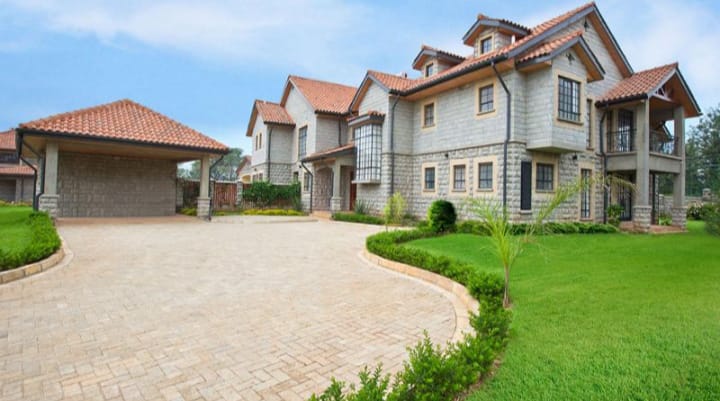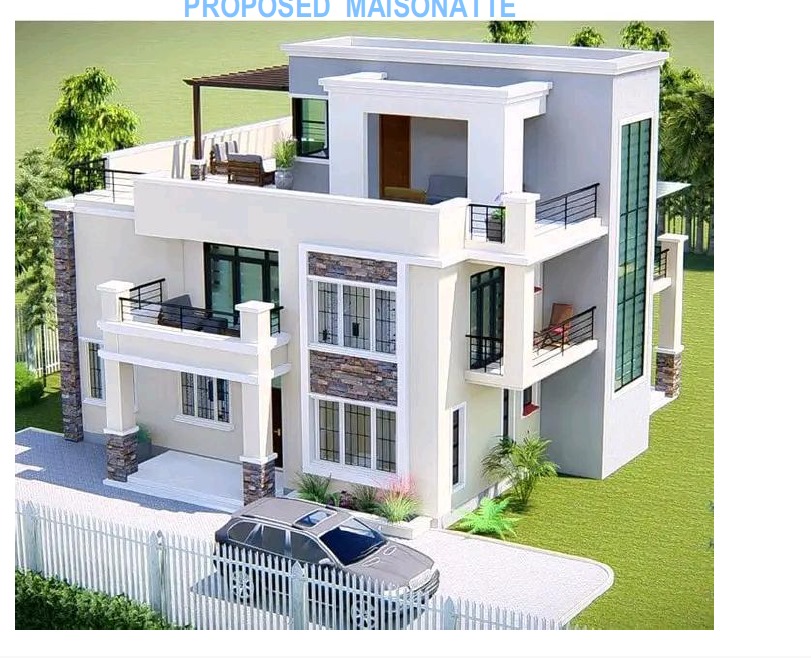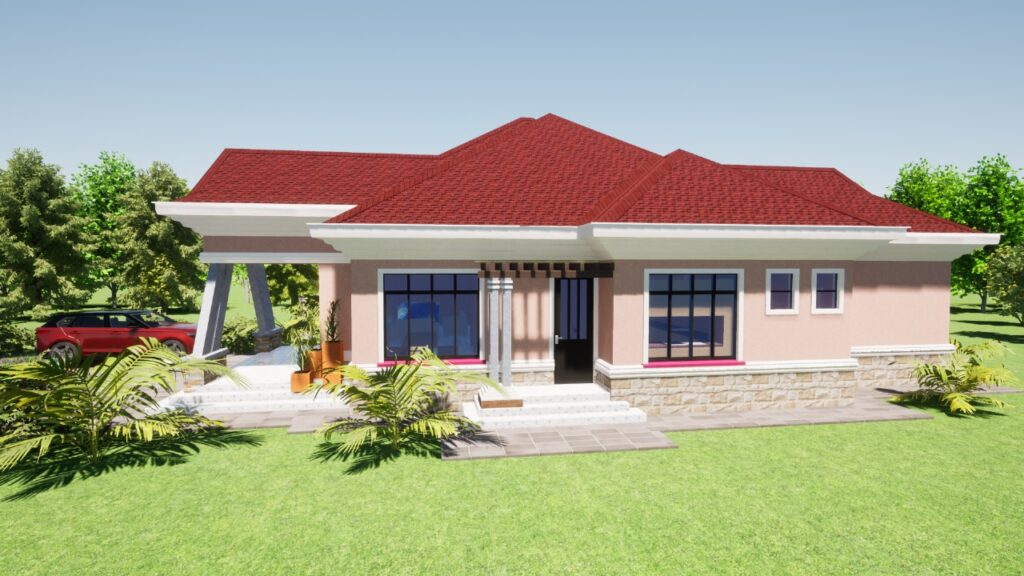Duplex vs Villa House Plan Kenya

Compare duplex vs villa house plan Kenya to find out which suits your budget, lifestyle, and investment goals. Discover design costs, plot requirements, ROI, and where to buy verified house plans in Kenya.
Introduction
When choosing between a duplex vs villa house plan in Kenya, understanding the key differences in cost, design, and purpose helps you make a smart investment. Both housing styles have grown in popularity due to rising urbanisation and modern living preferences. A duplex appeals to investors and extended families, while a villa suits homeowners seeking privacy and luxury. This guide breaks down all aspects — from costs and approvals to ROI — to help you select the right plan confidently.
What Is a Duplex House Plan?
A duplex house plan in Kenya refers to a two-unit residential design that can either be side-by-side or stacked vertically. Each unit typically has its own entrance, kitchen, and bedrooms, giving families privacy while sharing a plot and structural walls. Many duplexes in Nairobi and other counties are built on quarter-acre or smaller plots to maximise land use and rental returns.
Typical Features of Duplex Homes
Duplex homes usually have 3–4 bedrooms per unit, compact designs, and shared utilities like water and electricity. Their floor layouts often include mirrored living spaces to balance comfort and function. Because the structure is shared, the overall construction cost per square meter is lower compared to stand-alone villas, making duplexes ideal for investors or multi-family setups.
What Is a Villa House Plan?
A villa house plan Kenya is a spacious, standalone home emphasising comfort, privacy, and high-end finishes. Villas often feature luxury amenities like landscaped gardens, multiple lounges, servant quarters, and terraces. They are common in gated communities and upscale suburbs such as Karen, Runda, and Kiambu.
Key Elements of a Villa Design
Villa designs in Kenya typically range from 4 to 6 bedrooms, with ensuite bathrooms, modern kitchens, and outdoor spaces for relaxation. They are built on larger plots, often starting from half an acre, providing room for custom landscaping and outdoor entertainment areas. Villas focus on architectural elegance, making them more expensive but highly desirable for homeowners who value exclusivity and space

Cost Comparison: Duplex vs Villa in Kenya
Building costs vary significantly between duplexes and villas due to design complexity, materials, and land requirements. As of 2025, constructing a duplex costs approximately KSh 45,000–60,000 per square meter, while a villa ranges from KSh 65,000–90,000 per square meter depending on finishes. The initial design and structural drawings for both plans typically cost between KSh 80,000 and KSh 250,000 based on size and customisation level.
Factors Affecting Design and Construction Costs
Several factors determine total project cost, including plot size, soil condition, location, and level of luxury finishes. Duplexes use shared walls, reducing structural material costs, while villas require more extensive foundations and roofing systems. Hiring a qualified architect ensures compliance with local standards and can help you save by optimising design efficiency and material use.
Plot Requirements and Approvals
Plot suitability differs greatly between duplex and villa projects in Kenya. Duplexes can fit on smaller plots within urban areas like Nairobi or Mombasa, where land prices are high. Villas require larger plots to accommodate open spaces, driveways, and gardens, making them more suitable for suburban or rural settings.
Building Permits and County Approvals
Before construction, both duplex and villa house plans must receive approval from the respective County Government. The approval process involves submitting architectural drawings, structural plans, and NEMA clearance. It’s crucial to work with a registered architect or engineer who understands Kenya’s building code requirements to avoid penalties and costly redesigns later.
Return on Investment (ROI) and Rental Potential
The ROI for duplex vs villa house plan Kenya depends on location, target market, and purpose. Duplexes offer strong rental potential since each unit can be rented out separately, ensuring steady monthly income. Villas, however, provide high resale value and attract premium buyers, making them excellent long-term investments for capital appreciation.
Which Is More Profitable?
If your goal is to generate consistent cash flow, a duplex is often more profitable due to dual-unit rentals and faster occupancy. Villas, on the other hand, yield greater profits upon resale but require higher upfront capital. Your decision should align with your financial goals — whether income generation or lifestyle enhancement.
Maintenance, Utilities, and Sustainability
Maintenance costs are another key factor when choosing between these two house types. Duplex homes share walls, services, and infrastructure, lowering monthly maintenance costs. In contrast, villas are larger, with independent systems such as water pumps, security lights, and septic tanks, increasing maintenance requirements.
Sustainable and Energy-Saving Options
Sustainability has become a major design trend in Kenya. Both duplex and villa plans can integrate eco-friendly features like solar panels, rainwater harvesting, and energy-efficient lighting. Incorporating these systems from the design stage reduces future utility bills and supports sustainable living.
H2. Customisation, Design Options, and Timelines
When buying duplex house plans Kenya or villa house plans Kenya, you can choose between ready-made or custom designs. Ready-made plans are cheaper and faster to acquire, while custom designs allow you to personalise room layouts, finishes, and features. Most architects in Kenya can modify existing plans to suit your plot and budget.

Building Timelines and Process
Building a duplex typically takes 10–14 months depending on complexity, while villas can take 14–20 months. The process includes design approval, foundation work, superstructure, roofing, and finishing. Timelines vary based on funding consistency, contractor reliability, and weather conditions during construction.
Where to Buy Duplex and Villa House Plans in Kenya
Several trusted platforms sell or customise house plans locally. Websites like Maramani, AfroHousePlans, and Inuua offer downloadable designs in CAD and PDF formats. Alternatively, local architectural firms in Nairobi and other major towns can create tailor-made plans that meet your exact requirements.
Choosing the Right Vendor or Architect
Before buying, verify that the seller provides full documentation — architectural drawings, structural plans, and bills of quantities. Check reviews, previous work, and responsiveness to ensure professionalism. Investing in verified plans saves you from hidden costs or rejected permits during the construction phase.
Understanding Design Customisation and Modern Trends
In Kenya’s evolving housing market, design customisation has become an essential part of residential planning. Homeowners increasingly prefer flexible plans that blend functionality with modern style, whether it’s an urban duplex or a suburban villa. Architects are now integrating open-plan concepts, larger windows for natural light, and eco-friendly materials. For duplex owners, customisation may mean adding separate entrances or balconies for each unit to improve privacy and rental appeal. Villa owners, on the other hand, often prioritise aesthetics and luxury, focusing on high ceilings, spacious master suites, and outdoor entertainment areas. This shift toward personalisation reflects changing lifestyles, where comfort and sustainability are equally valued. Choosing a customisable house plan gives you control over finishes, layout, and flow, ensuring the design complements your daily routine. In Nairobi, Mombasa, and Kisumu, the trend leans toward hybrid designs that merge modern architecture with local materials like stone and clay tiles. Ultimately, customisation ensures your home stands out, functions efficiently, and meets both current and future needs.
Smart Home Integration in Modern House Plans
Smart home technology is becoming common in both duplex and villa house plans across Kenya. Features such as automated lighting, energy-efficient water heaters, and motion-sensitive security systems increase property value and reduce long-term costs. In villas, smart systems control everything from lighting ambiance to irrigation schedules for landscaped gardens, enhancing comfort and convenience. Duplex owners benefit by managing shared utilities more efficiently, tracking electricity or water usage separately for each unit. The integration process begins during design, allowing wiring and device compatibility to fit seamlessly into the structure. Smart home upgrades also align with Kenya’s growing middle-class preference for tech-enabled living spaces, reflecting a shift toward modern, connected living.
Sustainable Finishes and Local Material Choices
Architects now emphasise sustainable materials that reduce environmental impact while maintaining elegance. Locally sourced stone, bamboo, recycled wood, and solar tiles are gaining popularity because they are affordable and environmentally friendly. In duplexes, sustainability focuses on shared resources such as rainwater harvesting systems, while villas benefit from solar roofing and natural ventilation. Using green materials doesn’t just save money — it positions your home for long-term durability and eco-appeal. Homeowners who invest in sustainable designs also enjoy lower maintenance costs and better insulation, which keeps houses cooler in hot regions and warmer in highland areas.
Financing and Budget Planning for Duplex and Villa Projects
Building a duplex or villa in Kenya requires strong financial planning from the start. With construction costs rising, understanding your budget breakdown ensures you don’t stall midway. For duplexes, financing is often easier because of the income potential from renting out one or both units. Villas, however, require higher upfront capital but attract mortgage options from banks targeting high-income earners. Setting aside funds for permits, approvals, and architectural fees is crucial before breaking ground. Working with a financial advisor or quantity surveyor helps you forecast material costs, labor charges, and unexpected expenses like delays or redesigns. Budgeting for quality finishes from the start avoids costly modifications later. Whether you use savings, SACCO loans, or bank financing, ensure your loan terms align with your construction timeline to avoid cash flow issues.

Mortgage and Loan Options Available in Kenya
Kenyan financial institutions have developed flexible products for construction loans and mortgages tailored to self-builders. Banks such as NCBA, Co-op Bank, and KCB provide financing that disburses funds in stages as construction progresses. For duplex projects, the potential rental income can strengthen your loan application, while villas are assessed based on personal income or collateral value. SACCOs also provide low-interest alternatives that cater to mid-income builders. Before committing, compare repayment terms, processing fees, and insurance coverage to ensure affordability. It’s also advisable to work with architects who can provide accurate cost estimates to support your financing application.
Cost Control and Construction Efficiency
Cost control is essential once the project begins. Common techniques include sourcing materials directly from suppliers, hiring reputable contractors, and sticking to approved drawings. Frequent on-site supervision helps identify unnecessary variations that can inflate the budget. Builders should also schedule purchases during discount seasons or bulk deals to minimise cost per unit. For duplex projects, efficiency may involve building both units simultaneously to share labour and materials, while villa owners can phase out construction depending on funding availability. Proper planning ensures that even with economic fluctuations, your project stays within budget.
Legal Considerations and Land Ownership Documentation
Before construction starts, legal groundwork determines the success of your duplex or villa project. In Kenya, ensuring your title deed is clean and verified protects you from future disputes. Land ownership documents, survey maps, and mutation forms must match county records before approvals are issued. Duplex projects in urban settings must comply with zoning regulations to confirm multi-dwelling use, while villas fall under single-dwelling categories. County planners review the proposed design against plot ratios, set-back rules, and environmental impact before granting permits. Any legal inconsistency delays approval and may lead to demolition. It’s wise to involve a lawyer experienced in real estate development to confirm land status, easements, and encumbrances.
Leasehold vs Freehold Land in Kenya
Understanding whether your land is leasehold or freehold affects construction and ownership rights. Leasehold properties, often found in cities, require renewal after specific periods (commonly 99 years) and may attract ground rent or development conditions. Freehold properties, more common in rural areas, grant full ownership and fewer restrictions. For duplex developments, leasehold land is more practical in urban estates, while villas are commonly built on freehold plots for flexibility and long-term control. Always review the conditions on the title to avoid violating government regulations during development.
Approvals and Compliance Steps
The approval process involves submitting architectural, structural, and environmental documents to the county planning office. You’ll need to pay approval fees and obtain construction permits before laying the foundation. Builders must also follow NCA registration requirements for contractors and ensure insurance cover for site safety. Compliance guarantees your project meets legal standards and prevents future legal challenges.
Construction Supervision and Quality Assurance
Supervision ensures that every stage of your duplex or villa construction meets design standards and safety codes. Engaging a registered architect or project manager reduces errors that often result in costly rework. For duplex projects, supervision ensures both units are structurally balanced and aesthetically symmetrical. Villa construction, being larger and more complex, demands consistent oversight on plumbing, electrical work, and finishes. The project manager coordinates contractors, schedules inspections, and ensures timelines are met.

Selecting the Right Professionals
Hiring experienced professionals is key to quality construction. Choose architects registered with the Board of Registration of Architects and Quantity Surveyors (BORAQS) and contractors accredited by the National Construction Authority (NCA). Their credentials guarantee accountability and adherence to industry standards. Experienced professionals can also guide you on the right materials and structural techniques suited for Kenyan climates. Regular progress meetings between the client and team prevent misunderstandings and delays.
Quality Materials and Workmanship
Using substandard materials may save money in the short term but compromises the building’s lifespan. Always insist on certified materials from trusted suppliers and conduct random inspections. Skilled workmanship ensures finishes like tiling, roofing, and plastering meet professional standards. Villas require meticulous attention to detail due to luxury finishes, while duplexes demand consistency between both units. Good workmanship enhances the home’s aesthetic appeal and long-term value.
Long-Term Maintenance and Property Management
Once completed, maintaining your duplex or villa ensures its longevity and profitability. Duplexes, when rented out, require consistent upkeep of shared spaces such as driveways, gardens, and external walls. Villas, being larger and more private, need regular servicing of utilities like solar systems, water pumps, and security systems. Preventive maintenance minimises costly repairs later and keeps the property attractive for resale or rental.
Hiring Property Managers and Service Providers
For investors, hiring a professional property manager helps handle tenant screening, rent collection, and repairs. They also ensure compliance with tenancy laws and maintain the property’s condition. Villa owners may hire groundskeepers, cleaners, and security staff to maintain aesthetics and safety. The cost of property management varies depending on the property’s location and scale, but it’s worth the convenience and long-term peace of mind.
Renovations and Future Upgrades
Over time, you may consider upgrades such as modern kitchen fittings, solar installations, or new flooring. These improvements boost the home’s market value and attract tenants or buyers. For duplexes, renovations should maintain uniformity between units, while villa owners have flexibility to personalise interiors. Upgrading sustainably ensures your property remains modern and competitive in Kenya’s fast-evolving real estate market.

Conclusion — Which One Should You Choose?
The duplex vs villa house plan Kenya debate depends entirely on your budget, purpose, and lifestyle. Duplexes suit investors seeking rental income or extended families sharing a plot. Villas, meanwhile, fit those aiming for comfort, privacy, and luxury living. Evaluate your long-term goals, financing capacity, and land availability before making a final decision. Whichever you choose, ensure your plan complies with county laws and is designed by a certified architect for lasting value.